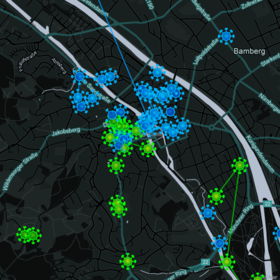EN/Ingress Timelapse
| Ingress TimeLapse (en) Status: stable | |
|---|---|

| |
| Beschreibung | screenshots over time |
| Autor: | schinken |
| PayPal | |
Description
To see the progress of Ingress in Bamberg we wanted to create a timelapse over a big period of time. To do so, we're using a headless firefox which takes screenshots running an "virtual" x server.
Here are two examples:
- Ingress Bamberg - 2013-05-06 16:56:44 to 2013-05-13 09:09:14
- Ingress Erlangen - 2013-05-07 16:09:21 to 2013-05-13 08:56:28
Firefox Setup
Create Profile
First you have to set up a new profile for Firefox. You can easily do this by just typing
firefox -P
into a terminal window. Firefox will now prompt you to create a new profile.
- Click the Create Profile-button
- Press Next to proceed on the Create Profile Wizard
- Enter your profile name - preferrably without spaces. e.g. use "ingress_cityname"
- Finish.
Firefox has now created a new user directory inside your home.
~/.mozilla/firefox/$randomnum.ingress_yourcity
Remember: If you want to take screenshots on a virtual machine/root-server you have to copy this profile to the machine using e.g. scp
Start firefox with your profile by clicking on "Start Firefox" or run it from console with:
firefox -P ingress_cityname
Log in to Google Account
To watch the intel map you need to log in to your Google account.
- Navigate to http://ingress.com/intel
- Log in to your Google account
- Allow Ingress to access your Google account
Choose your Viewport
On the Ingress intel map, just zoom in to the location you want to capture, and copy the link by using the "link" symbol in the upper right-hand corner. This link contains lat/lon coordinates and the zoom level of your current view.
Taking Screenshots
Dependencies
First you need to have these tools installed:
- firefox
- Xvfb
- avconv
You can install these scripts with the package manager of the linux distribution of your choice.
Start Script
Just create a clone of the ingress-screenshot repository somewhere:
git clone https://github.com/schinken/ingress-screenshot
and configure the run.sh-script with your favorite text editor (vim, emacs, etc..). The parameter names should be self-explanatory.
Simply run the bash script with:
./run.sh
After a couple of minutes/seconds your first screenshot should appear in your current directory.
Creating a Video
To create a video there is also a simple bash script in the git repository. Just run
./make_video.sh
This will do the dirty work for you.
FAQ
Needed
sudo apt-get install libavcodec-extra-53 imagemagick xvfb
Xlib: extension "RANDR" missing on display ":23".
This is mostly just a warning, and everything will work fine
run.sh: import: Command not found
Make sure you have imagemagick installed. Install it on Ubuntu with this command:
sudo apt-get install imagemagick
